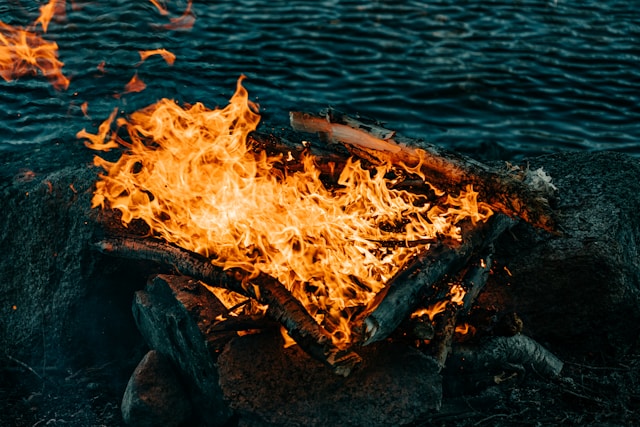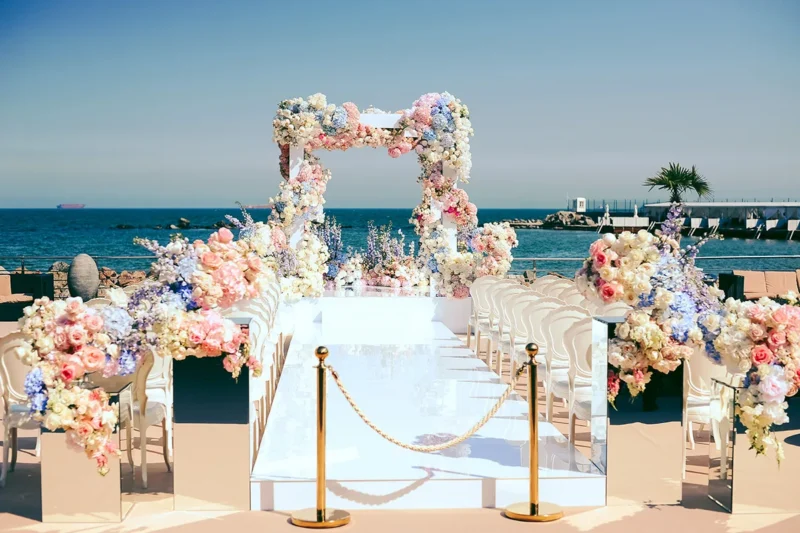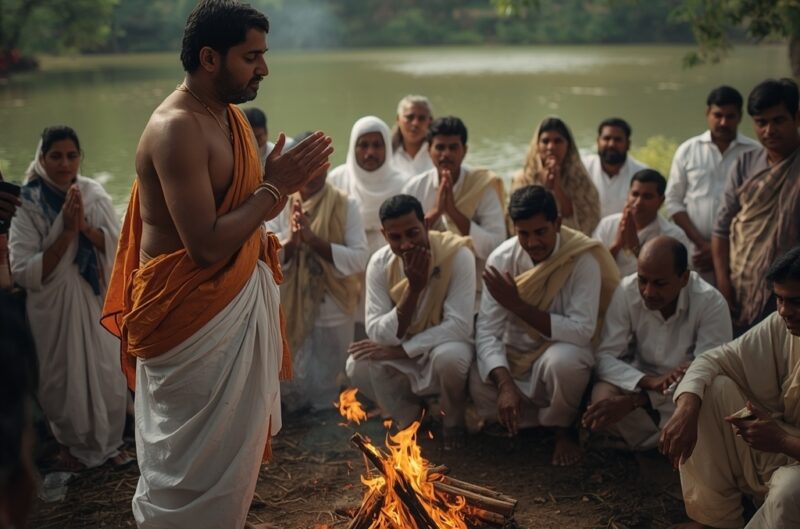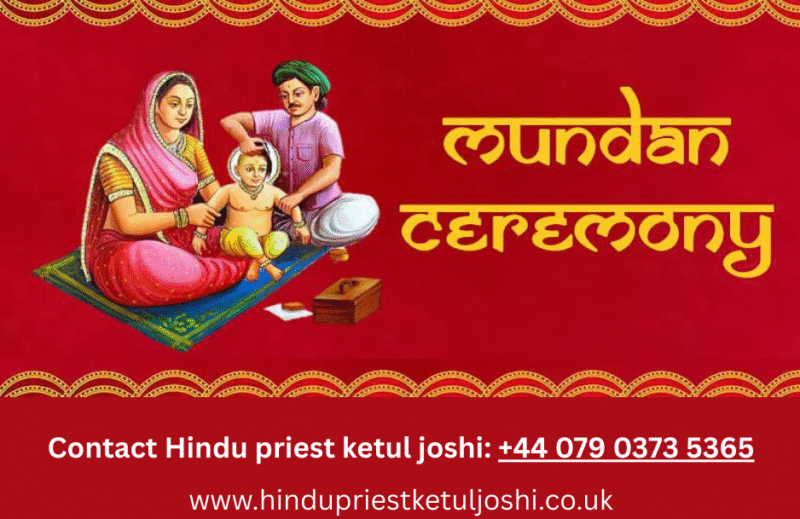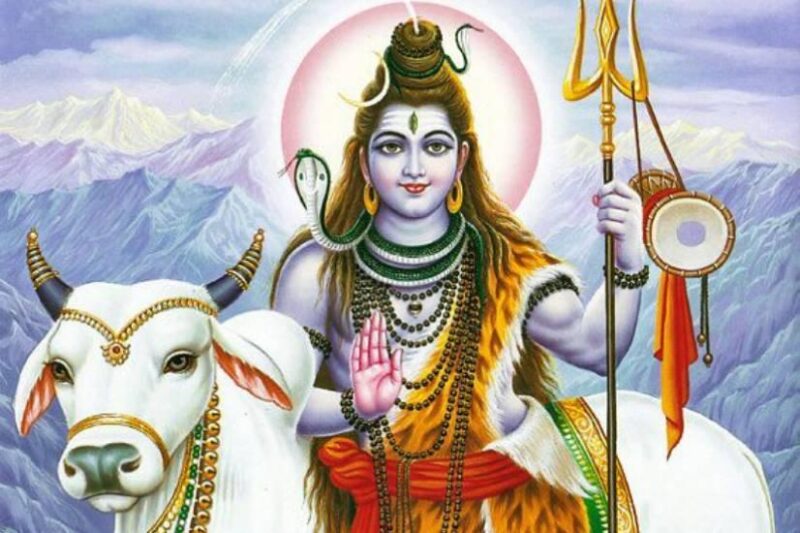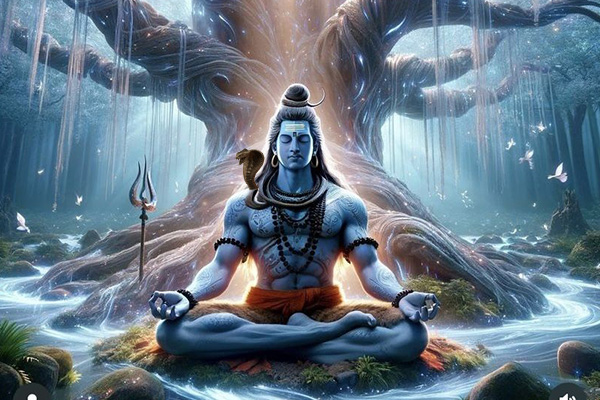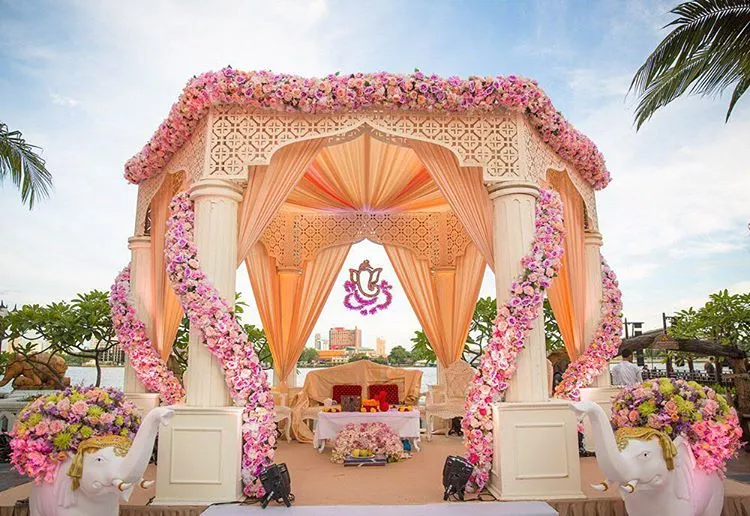Saptpadi and Seven Vows of Hindu Wedding

What does Saptapadi mean?
Saptapadi is associated with Hindu weddings and, specifically, Hindu wedding vows. Saptapadi is a sacred step taken together by the couple in front of the fire(in the presence of Agni), these are 7 steps or vows during their Hindu wedding ceremony. In the Saptapadi ceremony perform The main role by the Hindu priest for a wedding. as a wedding priest chanting the mantras during the Saptpadi. Indian priest (wedding priest) plays the main role in a Hindu wedding ceremony. Hindu priest for wedding plays the main role in the wedding ceremony.
In the Saptapadi ceremony, there is seven small pot of rice kept in this ceremony, the couple takes each step with their right foot beginning from the west direction and touch those 7 pots of rice one by one with every Vedic mantra recited by the wedding priest (Hindu pandit for wedding).
Saptapadi vows are taken in front of Hindu priests for weddings, elders, Pancha Tatva, and Demi-Gods to make them witness this sacred wedding. Here, couples circumambulate the sacred fire seven times: it symbolizes your union with your partner over seven lifetimes.
What happens in Saptapadi?
The couple holds each other’s hands, or their garments are knotted together, as you circumambulate the sacred fire, Agni. Agni is the Vedic God of Fire, who is the witness to all the promises made by the couple. It is believed that the presence of fire represents the all-powerful energy source, the Sun, as well as the life source, the digestive fire within us.
The Hindu Wedding rituals belief is that you are uniting each other’s names, addresses, families, and minds, and souls. Why this practice is so sacred is because, on this day, you are considered to be Lord Shiva and his consort, Goddess Parvati. So, your union is as unique as the divine! In fact, that is why you invoke gods and goddesses and invite family and friends – to witness the sacred and blessed union between you and your soulmate.
That is how important and sacred your union with your partner is considered to be. The elaborate Hindu wedding rituals acknowledge the solemnity and exclusivity of the vows – in all earnestness. In the same vein, these seven promises of marriage seek to unite you with your partner – forever.
In Hindu rituals While Saptapadi is a time-honored ritual in South India, Saat pheras (seven circumambulations) around the Agni is common in other parts, especially in North India.




In Gujarati Hindu weddings, couples only go around the fire four times. as per Hindu rituals guided by the wedding priest. When the couple gets married, they promise fulfillment in 4 major areas of life viz. during this ceremony Hindu priests chant mantras. Dharma(righteous path), Artha(wealth), Kama (love), and Moksha (liberation by abiding in attaining spiritual retreat with a spouse). Hence in many Indian communities, we can see 4 pheras or vows. During to four pheras Hindu pandit for wedding chanting mantras to fulfill the wedding ceremony.
The Legend of Saptapadi
There is a beautiful story behind the Saptapadi tradition in Hindu wedding rituals and how it began. The story of Savithri and Sathyavan. When her beloved husband, Sathyavan dies at an early age, his devoted wife, Savithri follows Yama, the God of death, as he carries away his soul. When Yama realizes that she is following him, he asks her to turn back. She replies that she has already walked more than seven steps with him and has become his friend. As his friend, she begins a conversation with him. With her wit and intelligence, she wins over the Lord of Death himself, who grants her husband his life again. Such is the importance of the seven steps at the beginning of a friendship or any relationship.
While love, probably, existed from the time life came into being, our ancestors had such clarity of vision concerning the union of two people. They understood that in the journey of life, each person is a friend and an equal partner. They acknowledged the possibility of divergent opinions, the importance of communication in resolving obstacles, and the need to complement and support each other through thick and thin. To such an extent, that even death cannot separate the souls that have united.
These seven promises of Hindu Wedding do not only serve the purpose of personal pledges or bonds made by each partner to live as one. They also take on greater significance in that they bind civilizations together over time and across distances. How? Can you think of anything that connects you with your great-grandfather? Blood ties? Well, apart from that, it is the common aspirations he had when he entered matrimony – that is encapsulated in the Saptapadi marriage vows.
The Seven Steps – What do they represent?
This portion of the ceremony takes place following the tying of the Mangalsutra (hyperlink) and establishes the commitment the couple makes to each other during the Hindu wedding ceremony. Saptapadi quite literally translates from Sanskrit to ‘seven steps’. Many are familiar with images across the Internet of Indian Brides leading their Grooms around the fire pit at the Mandap, but few know the significance of these steps.
In The Hindu wedding vows, we don’t have singular vows written by the couple. All the same, when you go through the process, you feel a tingle of excitement – as the momentousness of the time-tested tradition dawns on you. After all, these vows have been honored, repeated, and followed through the centuries.
The couple takes seven full circles, walking clockwise around the Agni, representing the seven principles and promises they make to each other; each step is referred to as a ‘phere’. They are tied together with the dupattas, or chunis, from the Granthi Bandhanam ritual, which is used to keep the couple united as they make their rounds. Although there is no literal part of the ceremony that represents the Western mentality of vow exchanging, these seven steps parallel that ideal in that the couple ‘vows’ to successfully fulfill these principles during their married life. Saptapadi’s 7 steps resemble seven areas of life that they need to work together to have a perfect marriage.
Traditionally the groom alone recites the vow of 7 steps but nowadays it is recited by both bride and groom. The couple takes these seven steps vow- saptapadi, together in the journey of their life. There are 2 ways of doing these rites, viz either groom can take the hold of the bride’s big toe of the right foot and move into the seven heaps of rice, or the couple can take it together, placing their toes together and move one by one with each Vedic mantra of saptapadi.
The following is a list of the promises the couple makes as they complete each full circle. While the couple is making their rounds, the Hindu wedding priest dictates mantras about each specific phere. The Groom takes the pinky finger (or hand) of his Bride and leads her for the first four pheras, and then they switch places and the Bride finishes the last three by leading him to the culminating step. Each of these pheras signifies a specific meaning for both the Bride and Groom – complementary meanings that ensure that they will work as a unit to make this marriage successful, healthy, and prosperous.
The significance of each Phera on Saptapadi
The 1st Phera or the 1st vow
‘May Lord Vishnu guide to nourishment’
“Om esha ekapadi bhava iti prathaman,dhanam dhanyam pade vader.”
In the first step of Phera, the couple vows for togetherness and nourishment for married life. Here, the couple prays to Lord Fire to bless with enough food and nourishment for the upcoming life. Here, the groom promises his bride to provide shelter, food and the bride also promises responsibilities towards partner and family.
Thus bride and groom promise to provide each other with the good things of life: food, physical and emotional nourishment, good health, wealth, and carry out duties and responsibilities to each other, family, and tradition. accepting each other’s responsibilities towards partner and family. So, all your basic needs are fulfilled.
The 2nd Phera or the 2nd vows
‘May Lord Vishnu bestow you to good health.’
“Om oorje jara dastayaha ,kutumburn rakshyammi sa aravindharam.”
In the second step of Phera, the couple prays for a healthy lifestyle to develop their mental and spiritual powers, timely meals which include exercise, avoiding bad habits like smoking, gambling, etc.
In this vow,, the couple promise to look after each other, praying for each other’s physical and mental health and strength. So, there is someone to take care of you at all times. , the couple prays for the blessings of mental and emotional support from fire God and bestows with the spiritual strength which helps them to support each other /family in a critical time and also defend their family from all types of odds.
The 3rd Phera or the 3rd vow
‘May Lord Vishnu guide to Prosperity and Security.’
“Om rayas santu joradastyaha,tava bhaktu as vadedvachacha.”
In the third step of Phera, the couple prays and says when we are fit enough for performing good karma, bless us to achieve success, prosperity throughout life.
In this vow, the couple prays to share the happiness and wealth and if the couple wants to earn more, they work together towards the betterment of their future and bestow with wealth through which they can do charity and spiritual growth. the couple promise to foster affection and liking towards each other. So, you feel cherished and loved, enabling the couple to become a better person.
The 4th Phera or the 4th vows
‘May Lord Vishnu guide you to consummate bliss.’
“Om mayo bhavyas jaradastayha, lalayami cha pade vadet.”
In the fourth step of Phera,, the Shastra depicts that couples should be blessed with a central element for marriage life, i.e healthy sex life. Here, the bride takes the lead and promises and prays to Fire God to bless with healthy children, she would love her husband in every possible way. The couple asks for love and bondage forever.
In this vow, the couple promise to be lifelong companions to acquire knowledge, happiness, and harmony by mutual love, respect, and trust. So, in good and bad times, you are not alone. They also take a vow to respect each other and their families.
The 5th Phera or the 5th vows
‘May Lord Vishnu guide you to the welfare of the children and domestic’ animals.’
“Om prajabhyaha santu jaradastayaha, arte arba sapade vadet.”
In the 5th Phera or step, the couple asks God for a blessing for 2 things, fertility for healthy heroic children and cattle. Please note in ancient times more properties and animals were said to signs of prosperity and investment.
In this vow, the couple prays to grow together: in thought and action. To find a common path amidst differing outlooks and to be blessed with a contended family of strong, virtuous, and heroic children
The 6th Phera or the 6th vow
‘May Lord Vishnu guide you to enjoyment according to the seasons.’
“Rutubhyah shat padi bhava, yajne home shashthe vacho vadet.”
In the 6th Phera or 6th Vow, it is said that the couple asks for the enjoyment of life whereas the bride takes responsibilities i.e playing together, vacation together, and enjoying the good things of life together is called an essential element for happy marriage life.
In this vow, the couple prays almighty for long lives togetherness. Here, Bride and Groom say to each other, “you have added immense bliss to my life by entering into this sacred ceremony, I wish you will always be with me by my side throughout my life.” Thus, couples vow to look after their children, family, and society, ensuring their prosperity together. So, with your union, everyone benefits.
The 7th Phera or the 7th vows
‘May Lord Vishnu guide you to in the actualization of your sevenfold spiritual energies.’
“Om sakhi jaradastayaha aatramshe sakshino vadet pade.”
In the 7th Phera or 7th Vow, it is said that realizing the ultimate purpose of life is spiritual evolution, i.e higher consciousness and unfold the potential of human life like mind, body, intelligence, strong will power and spiritual blessing from mentors and monks. Finally, the couple promises to adopt a noble bent of mind, leading a sacred and spiritual life, in the union. both groom and bride agree to walk the philosophical and spiritual path in life. The couple remains true companions, committed only to each other
In this vow, the couple united in harmony, affection, radiant with kind thoughts, which gives strength and enjoyment, hereby let our mind get united minds, bodies, spirits, and hearts. the couple enters into a new relationship of friendship and binds together, which keeps long-lasting. May this friendship binds them together, the intentions be of one accord, may the radiance be one, and mind gets united.
While the couple makes their rounds, family members that are present on the Mandap bless the couple with rose petals and rice, celebrating a pivotal part of the ceremony. After the Bride and Groom have made the seven rounds, they seek blessing from Lord Vishnu, the preserver, and Lakhsmi, the goddess of wealth. It is said that the couple has tied themselves together for seven lifetimes to come once this part of the ceremony is finished. Some regions of India finish the ceremony off by having the bride touch seven beetle nuts in turn with her toe, while her groom helps her keep her balance.
Thus, the Saptapadi vows to acknowledge and embrace all expectations and ambitions of couples. They have been designed in such a way that every dream you had, have, or will have in the future is included in the vows: to seek wealth, success, fame, or spirituality, to become a parent or a philanthropist. These timeless vows have included them all: acknowledging your right to grow and spread your wings in any direction with your special someone.
